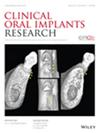The objective of this study is to analyze the clinical and radiographic outcomes of implant-supported fixed protheses with cantilever extensions (ISFPCs) in the partially edentulous anterior mandible.
Patients who received anterior mandible implant restoration between January 2016 and December 2021 were included. Patients with two, three, or four continuous missing teeth receiving adjacent implant supported single-unit crowns (ISSCs), ISFPCs, implant-supported fixed protheses without cantilever extensions (ISFPNs) were divided into groups: ISSC+ISSC, ISFPC, ISSC+ISFPC, three-unit ISFPN, ISFPC+ISFPC, or four-unit ISFPN, respectively. We recorded and evaluated survival rates, mechanical and biological complications, peri-implant marginal bone loss (MBL), esthetic outcomes, and patient perceptions. Statistical analysis was performed using linear mixed models (LMM).
The study included 87 patients and 152 implants. No implant loss occurred during an average follow-up of 3.48 ± 1.85 years (range: 1–7 years). According to LMM models, prosthetic type had a statistically significant impact on MBL during follow-up periods, in favor of the ISFPC and ISFPC+ISFPC groups (0.16 ± 0.48 mm vs. 0.51 ± 0.49 mm, p = .034; 0.22 ± 0.49 mm vs. 0.60 ± 0.62 mm, p = .043, respectively). Mechanical and biological complications were relatively low and comparable. The four-unit ISFPC group had higher subjective esthetic scores compared with the ISSC+ISSC group (98.6 vs. 83.8, p < .05), and patients in the ISFPC+ISFPC group expressed greater satisfaction with cleanability than the ISFPN group (98.8 vs. 80.6).
ISFPCs offer a highly predictable treatment option in the anterior mandible, characterized by high survival rates, and comparable complication rates, peri-implant bone stability and esthetics to adjacent ISSCs or ISFPNs.


